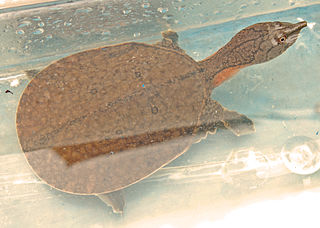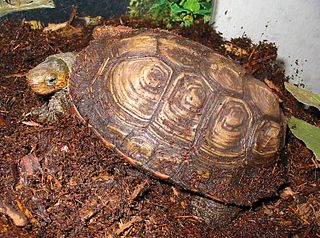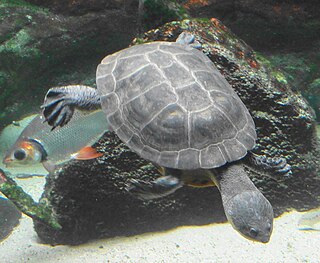
The mata mata, mata-mata, or matamata is a freshwater turtle species found in South America, primarily in the Amazon and Orinoco basins. It is one of two extant species in the genus Chelus, the other being Chelus orinocensis.

The Arrau turtle, also known as the South American river turtle, giant South American turtle, giant Amazon River turtle, Arrau sideneck turtle, Amazon River turtle or simply the Arrau, is the largest of the side-neck turtles (Pleurodira) and the largest freshwater turtle in Latin America. The species primarily feeds on plant material and typically nests in large groups on beaches. Due to hunting of adults, collecting of their eggs, pollution, habitat loss, and dams, the Arrau turtle is seriously threatened.

The eastern long-necked turtle is an east Australian species of snake-necked turtle that inhabits a wide variety of water bodies and is an opportunistic feeder. It is a side-necked turtle (Pleurodira), meaning that it bends its head sideways into its shell rather than pulling it directly back.

Cyclanorbis is a genus of softshell turtles in the family Trionychidae. The genus is endemic to Africa.

The Malayan softshell turtle is a species of softshell turtle in the family Trionychidae. It is monotypic in its genus.
The Namoi River snapping turtle, also commonly known as Bell's turtle, the Namoi River elseya, or Bell's saw-shelled turtle, is a species of turtle in the family Chelidae. The species is endemic to New South Wales, Australia.

Mauremys is a genus of turtles in the family Geoemydidae.
Dahl's toad-headed turtle is a medium-sized species of side-necked turle in the family Chelidae. This critically endangered freshwater turtle is endemic northern Colombia, where it lives in small pools, streams, and swamps, but aestivates on land.

The red side-necked turtle, red turtle, red-footed sideneck turtle, William's toadhead turtle, or red-footed Amazon side-necked turtle is a monotypic species of turtle in the family Chelidae. It is found in Colombia and possibly Peru and Brazil. This species is dimorphic in size meaning the sexes show different characteristics. One study found that the largest female out of a group of 24 was 256 mm in carapace length. Out of that same group, the largest male was only 199 mm in carapace length.

Vanderhaege's toad-headed turtle is a species of turtle in the family Chelidae. The species is endemic to South America.
The Zulia toad-headed sideneck, also known commonly as the Zulia toad-headed turtle, is a species of turtle in the family Chelidae. The species is endemic to Venezuela.

Rhinoclemmys is a genus of turtles in the family Geoemydidae, the only genus in the subfamily Rhinoclemmydinae. Member species of the genus are commonly known as the Neotropical wood turtles and are the only geoemydids known from the Americas. As such, they have adapted to a wide range of habitats, which is reflected in the species' common names.

Cyclemys is a genus of freshwater turtles, commonly referred to as Asian leaf turtles, from the family Geoemydidae. The genus occurs throughout Southeast and South Asia, and currently contains seven species.

Mesoclemmys is a South American genus of turtle in the Chelidae family.

The peninsula cooter is a species of freshwater turtle in the genus Pseudemys. It is sometimes considered a subspecies of the coastal plain cooter when that turtle is not itself considered a subspecies of the river cooter.

Phrynops geoffroanus, commonly known as Geoffroy's side-necked turtle or Geoffroy's toadhead turtle, is a species of large side-necked turtle in the family Chelidae. The species is endemic to South America.

Phrynops hilarii, commonly known as Hilaire’s toadhead turtle or Hilaire’s side-necked turtle, is a species of freshwater turtle in the family Chelidae. The species is endemic to South America.

The western black-bridged leaf turtle is a species of Asian leaf turtle found in southern Indochina.
Mesoclemmys nasuta is a species of turtle that lives in Bolivia, Colombia, Peru, Brazil and the Guyanas.
Mesoclemmys perplexa is a species of turtle from Northeast Brazil.
5. Vogt, R. C., Franco, J. A. G., Fernandes, T. undefined, & Cunha, F. undefined. (2019, March 29). Reproductive Biology and Hatchling Morphology of the Amazon Toad-headed Turtle (Mesoclemmys raniceps) (Testudines: Chelidae), with Notes on Species Morphology and Taxonomy of the Mesoclemmys Group. Vol. 18 issue 2. 195–209.














